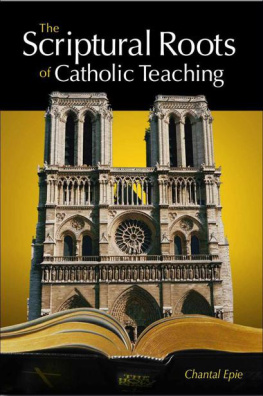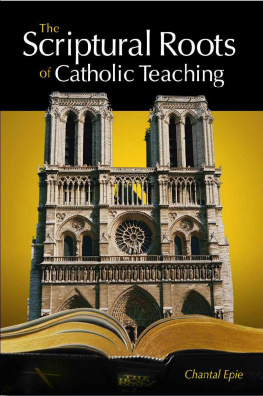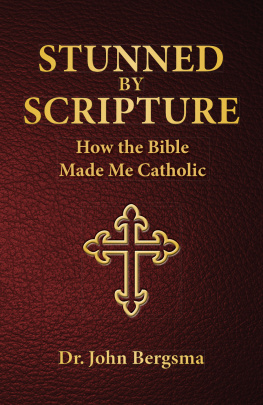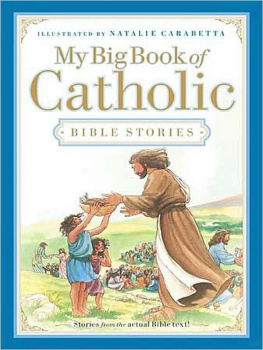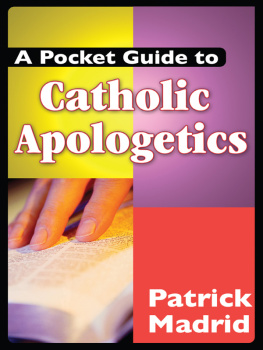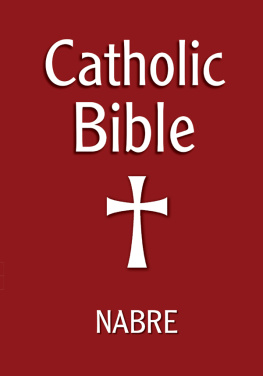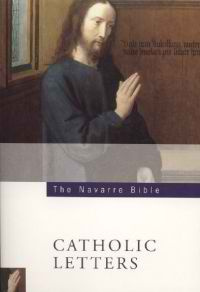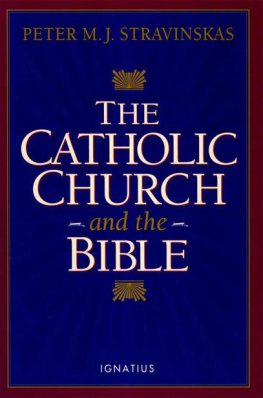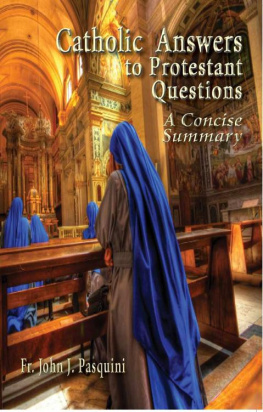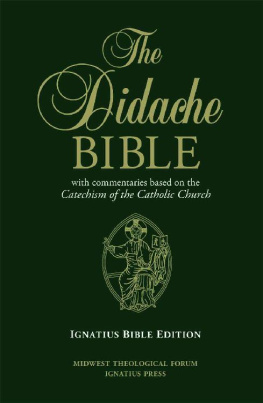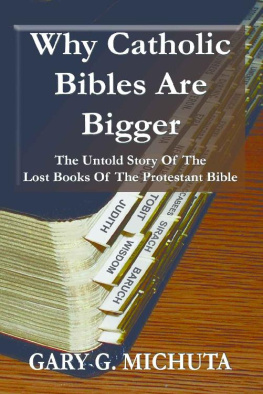The Scriptural Roots of Catholic Teaching
How the Bible Proves the Truth of the Catholic Faith
Chantal Epie
SOPHIA INSTITUTE PRESS
Manchester, New Hampshire
The Scriptural Roots of Catholic Teaching: How the Bible Proves the Truth of the Catholic Faith is a revised and updated edition of Upon This Rock: Scriptural Roots of Catholic Teaching (London: Scepter, 1991). Bible quotations are taken from the Knox translation.
Copyright 1991, 2002 Chantal Epie
Printed in the United States of America
Cover design by Theodore Schluenderfritz
No part of this book may be reproduced, stored in a retrieval system, or transmitted in any form, or by any means, electronic, mechanical, photocopying, or otherwise, without the prior written permission of the publisher, except by a reviewer, who may quote brief passages in a review.
Sophia Institute Press
Box 5284, Manchester, NH 03108
1-800-888-9344
www.SophiaInstitute.com
Nihil obstat:
Very Rev. Fr. J. M. Chapuli, S.T.D.
Imprimatur:
Most Rev. Dr. A. O. Okogie,
Archbishop of Lagos
June 26, 1991
Library of Congress Cataloging-in-Publication Data Epie, Chantal, 1949
The scriptural roots of Catholic teaching : how the Bible proves the truth of the Catholic faith / Chantal Epie. Rev. and updated ed.
p. cm.Rev. ed. of: Upon this rock. Includes bibliographical references (p. ).
ISBN 1-928832-53-9
1. Catholic Church Apologetic works. 2. Bible Evidences, authority, etc. I. Epie, Chantal, 1949- Upon this rock. II. Title.BX1752 .E65 2002
230.2 dc212002001127
Foreword
This book is addressed to Christians: it takes it for granted that the reader firmly believes that the Bible is inspired by God and free from error because it is Gods Word. Its purpose is to show the Church as it is depicted in the Bible, especially in the New Testament, and to help readers draw their own conclusions as to where this very same Church is to be found in modern times.
Those Christians who seek exclusively the guidance of Holy Scripture and adopt the principle of private interpretation of the Bible reject the concept of a Church as a visible society established by Christ, endowed with divine authority to govern and to teach (which is what the Catholic Church claims to be); they also reject the necessity of the sacraments, the need for Confession for the forgiveness of sins, devotion to saints, etc.
Yet the Bible has a lot to say on all these topics. But do we Christians read it attentively? How many fervent Christians have ever noticed that Holy Scripture tells of the divine approval of such Catholic practices as devotion to saints and to relics of saints? How many know that the Bible says that not all Gods Revelation is written within its pages? How many have paid attention to the letters of St. Peter, in which the Holy Spirit tells us that Holy Scripture can be very difficult to understand and its meaning very easy to distort if we rely exclusively on private interpretation?
One objective of this study is to help Christians to read the Bible with an understanding of its full meaning and, consequently, to discover, emerging from the pages of the sacred books, the Catholic Church as it is today, as it has been throughout the centuries following the work of Redemption carried out by Christ.
So this book has been written especially for Catholics who wish to strengthen their Faith by increasing their knowledge of the biblical sources of Revelation. But it is also addressed to all people of goodwill who wish to become better acquainted with what the Bible says concerning Christs teachings and the life of the first Christians, the immediate disciples of Jesus and of the Apostles.
With this purpose in view, the scope of this book is necessarily limited. No attempt has been made to bring forward proofs from the solemn definitions of dogmas of Faith. In spite of their primordial importance, hardly any reference has been made to conciliar and papal documents; for a complete explanation of Christian doctrine, there are other more appropriate publications (see recommended reading). This book aims only at presenting the scriptural proofs of the Churchs teachings, by studying the biblical texts directly related to the institution of the Church by Christ, the action of the Holy Spirit in the Church, the forgiveness of sin, the Mother of the Redeemer, and other points of Catholic doctrine. However, whenever they shed light on the sacred text, extrabiblical historical facts have been used to reinforce the scriptural proofs.
Chapter One

God reveals Himself in many ways
Stand firm, then, brethren, and hold by the traditions you have learned, in word or in writing, from us.
2 Thessalonians 2:14

The Good News was first preached orally
Those who had been driven away spread the gospel as they went from place to place.
The part of the Bible that we call the New Testament was not handed down to us from Heaven in its written form. Christianity is not a written religion as such, differing in this from Islam. Mohammed claimed that an angel had given him the book of the Koran, and from that moment he started his religious teaching; not so in the case of Jesus Christ.
Jesus Himself never wrote a word on paper for us. The only time He is known to have been writing was in the dust of the ground. He was always teaching verbally, traveling from village to village, and He trained His Apostles to do the same. By the time the Faith had spread to Damascus, and then to the rest of Asia Minor, Greece, and Rome, there was still nothing written down under the inspiration of the Holy Spirit.
The first Gospel to be recorded in writing was that of St. Matthew. He wrote in Aramaic for the Jewish Christians of Palestine approximately in the year 50. This original version does not seem to have been used outside the Holy Land, because, after the destruction of Jerusalem in the year 70, when the city was reduced to a pile of rubble and the sacred books were burned, no copy of it could be found. There was, however, a Greek translation of this Gospel, and this is the version that we possess now. So, for twenty years, there was no written Gospel, and yet the Good News of the Lord Jesus had spread like fire throughout the Roman Empire.
St. Marks Gospel was written around the year 60. St. Lukes was written after Marks, but before the destruction of Jerusalem, and John was a very old man when he wrote his Gospel and letters, toward the end of the first century.
In two of his letters, the apostle John states in nearly identical terms that he still has many things to say, but he does not want to put them down on paper and prefers to speak face-toface. yet, what we can read about those forty days is very brief and sketchy.
So it appears clearly that there was a considerable part of the Lords teachings, later taught in their turn by the Apostles, that was not written down and cannot therefore be found in the Bible. These teachings, however, were faithfully transmitted to the Christian communities.
In his two letters to the Thessalonians, written between the years 50 and 52, at a time when only St. Matthews Gospel existed, St. Paul bears witness to this oral teaching that has to be received as Gods words: This is why we give thanks to God unceasingly: that, when we delivered the divine message to you, you recognized it for what it is, Gods message, not mans.
If we want to be faithful to Gods word, we have to accept both the written revelation and this other part of revelation that was handed down to us by word of mouth and preserved for all generations in the Tradition of the Church.
In conclusion, we can affirm that the Bible itself says that not everything taught by Christ is written within its pages. In addition, it qualifies as Gods message the oral teaching of the Apostles. As the Bible is the word of God, we can safely conclude that God has warned us that His revelation is to be found not only in Holy Scripture, but also in the Tradition of the Church, transmitted from generation to generation by word of mouth, then also in the writings of early Christians such as St. Polycarp, disciple of St. John, St. Ignatius of Antioch, St. Augustine, etc. Obviously, there can be no contradiction between Holy Scripture and Tradition, as both take their origin from the revelation of the one true God.
Next page
